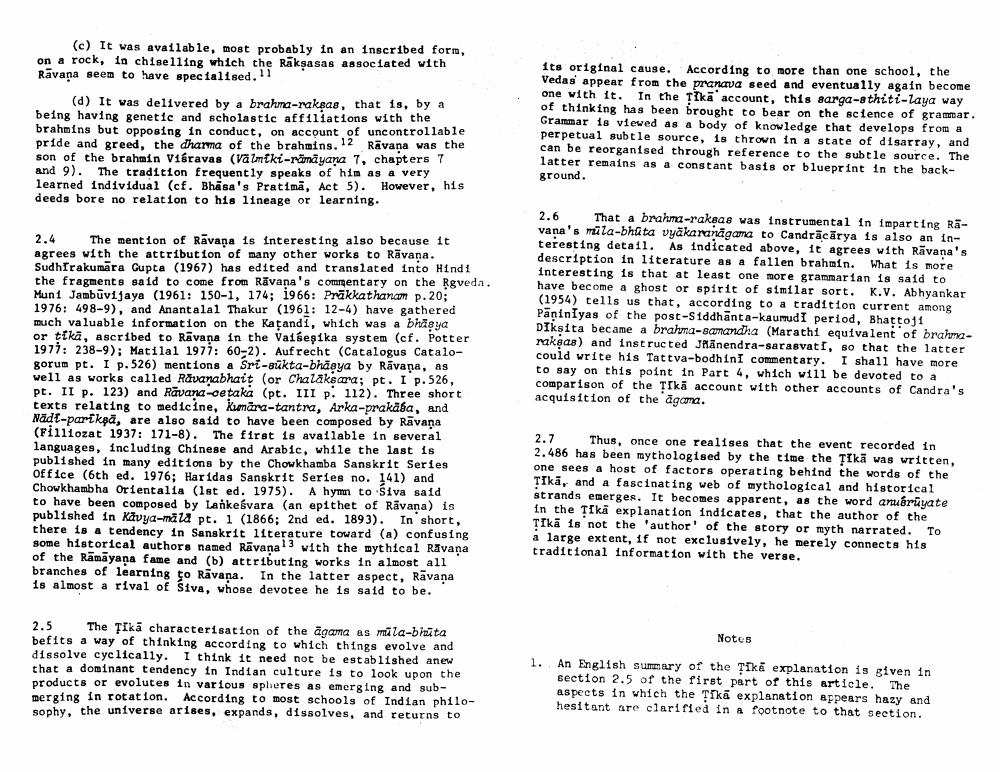Book Title: Interpreting Vakyapadiya 2486 Historically Author(s): Ashok Aklujkar Publisher: Ashok Aklujkar View full book textPage 3
________________ (c) It was available, most probably in an inscribed form, on a rock, in chiselling which the Raksasas associated with Ravana seem to have specialised. 11 (d) It was delivered by a brahma-raksas, that is, by a being having genetic and scholastic affiliations with the brahmins but opposing in conduct, on account of uncontrollable pride and greed, the dharma of the brahmins. 12 Rāvana was the son of the brahmin Višravas (valmłki-rämayana 7, chapters 7 and 9). The tradition frequently speaks of him as a very learned Individual (cf. Bhasa's Pratima, Act 5). However, his deeds bore no relation to his lineage or learning. 1ts original cause. According to more than one school, the Vedas appear from the pranava seed and eventually again become one with it. In the Tikā account, this sarga-sthiti-laya way of thinking has been brought to bear on the science of grammar. Grammar to viewed as a body of knowledge that develops from a perpetual subtle source, is thrown in a state of disarray, and can be reorganised through reference to the subtle source. The latter remains as a constant basis or blueprint in the background. 2.6 That a brahma-rakeas was instrumental in imparting Rāvana's mula-bhata vyakaranagama to Candrācārya is also an interesting detail. As indicated above, it agrees with Ravana's description in literature as a fallen brahmin. What is more interesting is that at least one more grammarian is said to have become a ghost or spirit of similar sort. K.V. Abhyankar (1954) tells us that, according to a tradition current among Paniniyas of the post-Siddhānta-kaumudI period, Bhattoji DIkşita became a brahma-sanandha (Marathi equivalent of brahmamaksas) and instructed Jaanendra-sarasvati, so that the latter could write his Tattva-bodhinI commentary. I shall have more to say on this point in Part 4, which will be devoted to a comparison of the Tikā account with other accounts of Candra's acquisition of the agcona. 2.4 The mention of Rāvana is Interesting also because it agrees with the attribution of many other works to Ravana. Sudhirakumāra Gupta (1967) has edited and translated into Hindi the fragments said to come from Rāvana's commentary on the Reveda. Mun 1 Jambūvijaya (1961: 150-1, 174; 1966: Prākkathanam p. 20; 1976: 498-9), and Anantalal Thakur (1961: 12-4) have gathered much valuable information on the Kaçandi, which was a bhagya or tłka, ascribed to Rāvana in the Vaisepika system (cf. Potter 1971: 238-9); Matilal 1977: 60-2). Aufrecht (Catalogus gorum pt. I p. 526) mentions a Sri-sukta-bhagya by Rāvana, as well as works called Ravanabhait (or Chalaksana; pt. I p. 526, Pt. II p. 123) and Rāvana-cetaka (pt. III p. 112). Three short texts relating to medicine, Kumara-tantra, Arka-prakaba, and Nadt-parłkpa, are also said to have been composed by Ravana (Filliozat 1937: 171-8). The first is available in several languages, including Chinese and Arabic, while the last is In many editions by the Chowkhamba Sanskrit Series Office (6th ed. 1976; Haridas Sanskrit Series no. 141) and Chowkhambha Orientalia (1st ed. 1975). A hymn to Siva said to have been composed by Lankeśvara (an epithet of Rāvana) is published in Kavya-mala pt. 1 (1866; 2nd ed. 1893). In short, there is a tendency in Sanskrit literature toward (a) confusing some historical authors named Ravana13 with the mythical Ravana of the Rāmāyana fame and (b) attributing works in almost all branches of learning to Ravana. In the latter aspect, Rāvana is almost a rival of Siva, whose devotee he is said to be. 2.7 Thus, once one realises that the event recorded in 2.486 has been mythologised by the time the fiki was written, one sees a host of factors operating behind the words of the Tikā, and a fascinating web of mythological and historical strands emerges. It becomes apparent, as the word amuruyate in the Tiki explanation indicates, that the author of the Tikā is not the author' of the story or myth narrated. To a large extent, 1f not exclusively, he merely connects his traditional information with the verse. Notes 2.5 The Fika characterisation of the agama as mila-bisita befits a way of thinking according to which things evolve and dissolve cyclically. I think it need not be established anew that a dominant tendency in Indian culture is to look upon the products or evolutes in various spheres as emerging and submerging in rotation. According to most schools of Indian philosophy, the universe arises, expands, dissolves, and returns to 1. An English summary of the TikZ explanation is given in section 2.5 of the first part of this article. The aspects in which the Tıká explanation appears hazy and hesitant are clarified in footnote to that section.Page Navigation
1 2 3 4 5 6
